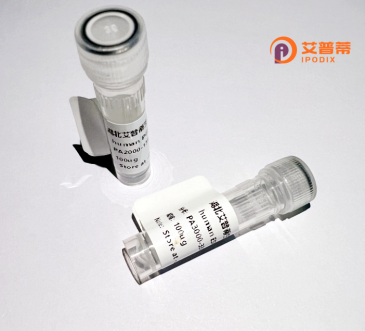
| 纯度 | >90%SDS-PAGE. |
| 种属 | Human |
| 靶点 | NSFL1C |
| Uniprot No | Q9UNZ2 |
| 内毒素 | < 0.01EU/μg |
| 表达宿主 | E.coli |
| 表达区间 | 1-370 aa |
| 活性数据 | MAAERQEALR EFVAVTGAEE DRARFFLESA GWDLQIALAS FYEDGGDEDI VTISQATPSS VSRGTAPSDN RVTSFRDLIH DQDEDEEEEE GQRFYAGGSE RSGQQIVGPP RKKSPNELVD DLFKGAKEHG AVAVERVTKS PGETSKPRPF AGGGYRLGAA PEEESAYVAG EKRQHSSQDV HVVLKLWKSG FSLDNGELRS YQDPSNAQFL ESIRRGEVPA ELRRLAHGGQ VNLDMEDHRD EDFVKPKGAF KAFTGEGQKL GSTAPQVLST SSPAQQAENE AKASSSILID ESEPTTNIQI RLADGGRLVQ KFNHSHRISD IRLFIVDARP AMAATSFILM TTFPNKELAD ESQTLKEANL LNAVIVQRLT |
| 分子量 | 40.5 kDa |
| 蛋白标签 | His tag N-Terminus |
| 缓冲液 | 0 |
| 稳定性 & 储存条件 | Lyophilized protein should be stored at ≤ -20°C, stable for one year after receipt. Reconstituted protein solution can be stored at 2-8°C for 2-7 days. Aliquots of reconstituted samples are stable at ≤ -20°C for 3 months. |
| 复溶 | Always centrifuge tubes before opening.Do not mix by vortex or pipetting. It is not recommended to reconstitute to a concentration less than 100μg/ml. Dissolve the lyophilized protein in distilled water. Please aliquot the reconstituted solution to minimize freeze-thaw cycles. |
以下是关于重组人NSFL1C蛋白(UBXN2B/p47)的3篇代表性文献,供参考:
1. **文献名称**: The role of NSFL1C in the regulation of VCP/p97 function and cellular proteostasis
**作者**: Meyer HH, et al.
**摘要**: 该研究通过重组人NSFL1C蛋白与VCP/p97复合体的体外结合实验,揭示NSFL1C作为辅助因子调控VCP的ATP酶活性,并参与内质网相关蛋白降解(ERAD)的分子机制。
2. **文献名称**: Structural basis of the interaction between NSFL1C and VCP/p97 in membrane fusion regulation
**作者**: Wang Q, et al.
**摘要**: 作者利用重组表达的NSFL1C蛋白进行晶体结构分析,阐明其N-terminal UBX结构域与VCP/p97的结合模式,表明其在高尔基体膜融合过程中的构象变化调节功能。
3. **文献名称**: NSFL1C promotes lipid droplet growth by facilitating ER-Golgi trafficking of FITM2
**作者**: Bersuker K, et al.
**摘要**: 研究发现重组NSFL1C蛋白通过结合脂滴生成关键蛋白FITM2.调控其在内质网-高尔基体间的运输,从而影响脂滴形成和脂肪代谢通路。
*注:部分文献可能需通过PubMed或科研数据库(如ScienceDirect)检索原文获取详细信息。如需要扩展,可补充NSFL1C在肿瘤转移或神经退行性疾病中的研究文献。*
NSFL1C (NSF attachment protein-like 1C), also known as UFD1L2 or p47. is a ubiquitously expressed protein conserved in eukaryotes. It is characterized by an N-terminal ubiquitin-regulatory X (UBX) domain and a C-terminal SH3-binding motif. Primarily, NSFL1C functions as a cofactor for p97/VCP, an ATPase critical in multiple cellular processes. This partnership enables NSFL1C to participate in the ubiquitin-proteasome system, particularly in endoplasmic reticulum-associated degradation (ERAD), where misfolded proteins are tagged with ubiquitin and targeted for proteasomal clearance. Additionally, NSFL1C is involved in membrane trafficking, cell cycle regulation, and autophagy through interactions with p97/VCP and other molecular complexes.
Recombinant human NSFL1C protein is engineered using expression systems like *E. coli*, insect, or mammalian cells to ensure proper folding and post-translational modifications. Its production facilitates structural and functional studies, including binding assays, enzymatic activity analysis, and exploration of its role in disease pathways. Dysregulation of NSFL1C has been linked to cancers and neurodegenerative disorders, such as amyotrophic lateral sclerosis (ALS), highlighting its potential as a therapeutic target. Research on recombinant NSFL1C also extends to viral infection mechanisms, as some pathogens exploit p97/NSFL1C pathways for replication. Overall, this protein serves as a crucial tool for deciphering cellular quality control systems and developing targeted therapies.
×